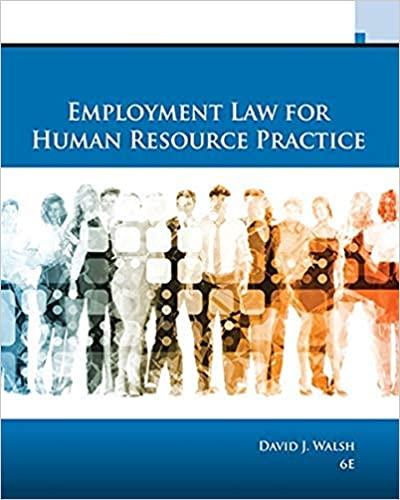Plaintiff, an emergency medical technician employed by defendant, was terminated within hours of complaining to her supervisors
Question:
Plaintiff, an emergency medical technician employed by defendant, was terminated within hours of complaining to her supervisors that a male co-worker had sent her a text message containing a graphic, sexual photograph. Plaintiff alleged that when her male co-worker learned that she had complained, he manipulated his iPhone to make it appear that a conversation containing consensual sexual text banter that he had with another person was a conversation between him and the plaintiff, and, when questioned by the employer about plaintiff’s allegations, provided printed screen shots of portions of this alleged conversation, telling the employer that he and plaintiff had been involved in a consensual relationship. In her lawsuit, plaintiff complained that her employer accepted the coworker’s tale as true, and rejected her offer to turn over her cell phone for inspection or otherwise refute his claim. Instead, plaintiff asserted that she was told by her employer that it “knew the truth,” and that she had a sexual relationship with the co-worker, and that her employment was being terminated because she had sexually harassed him. Plaintiff filed suit, asserting that the employer’s decision to terminate her employment was an act of retaliation in violation of Title VII because she had voiced complaints of sexual harassment. Relying on the “cat’s paw” doctrine, plaintiff argued that the employer’s decision to terminate her employment was influenced by false information provided by her male co-worker. The district court dismissed her complaint, concluding that an employer could not be held liable under the “cat’s paw” doctrine for the discriminatory or retaliatory intent of a non-supervisory co-worker. On appeal, the Second Circuit disagreed and reinstated plaintiff’s complaint. Despite the fact that the male co-worker was a low-level employee without any supervisor authority, the Second Circuit held that the employer’s “own negligence provides an independent basis” to treat the male co-worker as its agent and hold it accountable for his illegitimate intent. Referencing the allegations that the employer “blindly credited” the male co-worker’s assertions and “obstinately refus[ed] to inspect plaintiff’s phone or to review any other evidence she offered in refutation, the Second Circuit concluded that “an employer may be held liable for an employee’s animus under a ‘cat’s paw’ theory, regardless of the employee’s role within the organization, if the employer’s own negligence gives effect to the employee’s animus, and causes the victim to suffer an adverse employment action.”
1. What were the legal issues in this case? What did the appeals court decide?
2. What is the subordinate bias or “cat’s paw” theory of liability?
3. Why should an employer be held liable for the discriminatory or retaliatory motive of a low-level employee with no authority to make or recommend employment decisions?
4. What is the evidence that this employer was negligent in relying on the “information” provided by the coworker? What should this employer have done instead?
5. Do you agree with the decision in this case? Why or why not? Should the employer also be liable for the harassment suffered by Vasquez? Why or why not?
Step by Step Answer:






